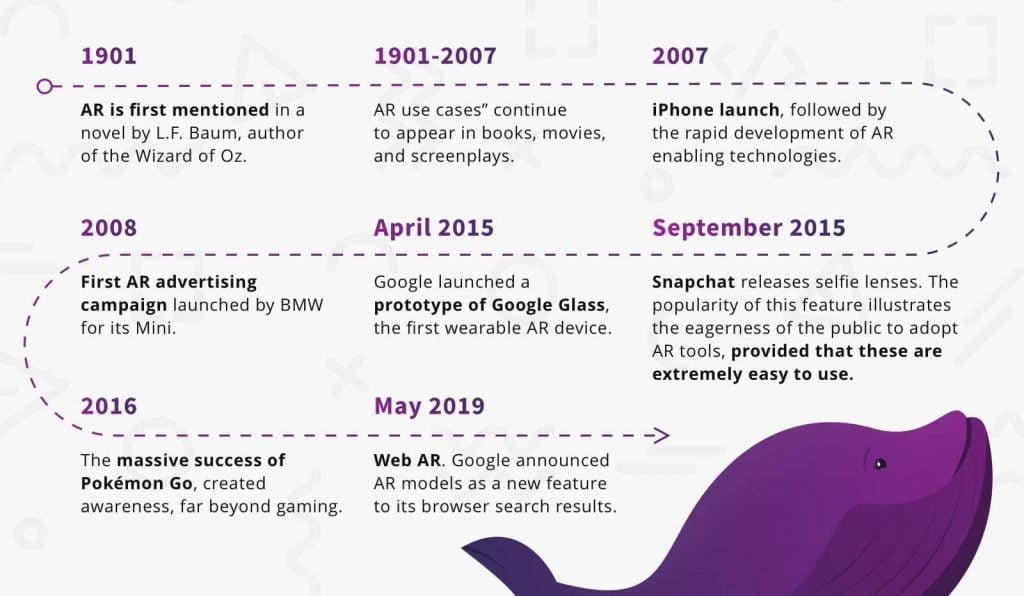The past, present, and future of Augmented Reality
Contents
When people think of Augmented Reality (AR), most likely they will think of it as something that has recently been invented. So, it might come as a surprise to many when they hear that it has a much longer history than most people are aware of.
We have to go back to an illustrated novel written by L.Frank Baum as early as 1901, where a kind of Augmented Reality is mentioned, at least when we look at it in retrospect. He writes about the adventures of a boy with a pair of spectacles that allow him to see superimposed images on people’s foreheads.


In 1968 we find the first real steps of AR, when a Harvard professor and computer scientist called Ivan Sutherland created the ‘Sword of Damocles’, or first head-mounted display, together with his student Bob Sproull. Although we can count this as the first step of VR as well, seeing as back then the difference between AR and VR was not as clearly defined as it is today.
The term Augmented Reality as such did not exist until 1990 when Boeing researchers Tom Caudell and David Mizell came up with it while designing a system that could help and guide workers to assemble complicated parts of a new jetliner by using a see-through display. His system did not succeed but the name for it, Augmented Reality, was born to stay.
Two years later in 1992, Louis Rosenberg created Virtual Fixtures, a fully immersive system that combined AR and VR. But it wasn’t until 1998 that AR was used for the first time in NASA’s X-38 spacecraft.
In 2000 the first AR game called ARQuake was launched by Bruce Thomas, where players had to wear a head-mounted display with a backpack that contained gyroscopes and a computer.
The evolution of Augmented Reality
The years after, Augmented Reality appeared for commercial purposes. One of those successful apps is IKEA Place that uses AR to place digital furniture in your house to see how it looks. But it was the game Pokemon GO that really made a big difference in making AR popular among the masses.


Despite all these developments, Augmented Reality is still not mainstream although the development of frameworks like Apple’s ARKit and Google’s ARCore is a milestone when it comes to including AR into apps published on the two main platforms App Store and Play Store.
From there on, the improvement and popularity of AR have only risen and will continue to do so because the real potential of Augmented Reality has still far to go. Think of all the industries that can benefit immensely from AR like retail, marketing, healthcare, education, to name a few. With AR, these sectors can provide more personalized training, create immersive experiences for customers, improve work safety and much more.
The future of AR
Even though Augmented Reality is still not considered mainstream, at Onirix we are working every day on changing this, so AR becomes more accessible to everyone. Competitively priced wearables or glasses are still missing to help the technology take a big leap. Once those are available AR will be able to make a final breakthrough.
Currently, there are only two wearables that have commercial significance, one is Microsoft’s Hololens and the other is Magic Leap One. However, due to their pricing, these products are more fit for industrial applications.


So, if we want Augmented Reality to become more mainstream that means we will need other developments as well, like more apps that use AR as a tech to become available. But also, wearables that are in a different price range than the two mentioned earlier. Think of Google Glass or the much-awaited Apple smart glasses that are supposed to come out in 2020.
And finally, Web AR that will give a big impulse to Augmented Reality to become more mainstream. It will eliminate the need for specialized apps and thus making AR available inside any web browser.
We can conclude there is still a way to go in Augmented Reality, but the potential is endless. This is why, at Onirix, we are excited to be a part of this process of making AR accessible to everyone and explore all the potential AR has to offer. We’ll be back with more!

